Supported Data Formats
Restoring data from encapsulated formats requires deep technical knowledge and experience.
Tape Formats
At Tape Ark, we specialize in rapidly migrating media tapes to the cloud, regardless of volume, size, or format.
Tape Migration: Virtualization
The world’s only dedicated tape to cloud mass migration experts.
Tape Storage
When undergoing a tape to cloud migration journey it is important to avoid paying for multiple sets of storage.










